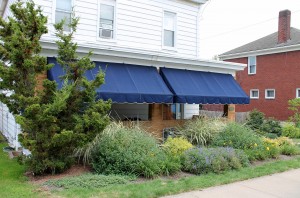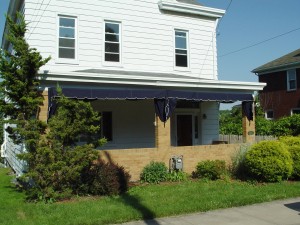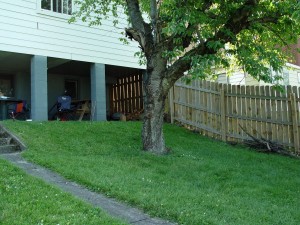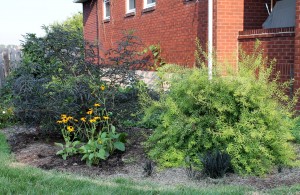“Y’ins Are Making Our Yard Look Stupid”
August 29th, 2012
Sometimes it’s easiest to start from scratch.
Once landscapes (like people) wear out or grow bigger than they ought to, it sometimes makes more sense to yank and start over than to try and fine-tune your way back into business.
That’s the approach we’re taking at my son and daughter-in-law’s place in the small Pittsburgh-area borough of Munhall.
Andy and Julie moved into an older home two springs ago that had two half-dead trees in the back yard, a skinny house-front bed of overgrown grasses and golden falsecypresses, and mostly grass and weeds everywhere else.
But the hilly lot has a ton of landscape potential (the only part of home-ownership that I know much about). So for the last two summers, we’ve been working on a Munhall makeover. I just got back from phase two last week – installing a water garden on a back-yard slope.
This area runs down a slope from the back covered patio. It’s a nice place to sit and look out over the valley.
It wasn’t looking so good, though, with a rotted old cherry tree that had only one living limb. My son and a friend cut it down before it blew over like the other half-dead tree – a crabapple – that went down in a storm the day they moved in.
We got a pre-formed pond for the hill and situated it near the top of the slope so A.) it’d be easily visible from the patio, and B.) the dropping water would muffle the sound of a nearby A/C unit.
Leveling was the tricky part. We didn’t have to dig much (an advantage of building a pond on a slope), but we did have to wheelbarrow in 4 yards of topsoil to bring up the slope and create the new taper. We’ll add a retaining wall farther down and finish off the surrounding garden later.
My favorite touch was what we used for the falls – the big stump from the cherry tree. This 2-foot-tall fat wood chunk had several openings where big branches had fallen off and rotted. We snaked the pump hose up through one of the openings, tacked on a few pieces of bark to make a water-deflecting hood, and ended up with an interesting, natural and personalized feature (also free).
Elsewhere, the three-tiered raised-bed veggie-garden boxes on the slope next to the house are already producing lots of cucumbers, red beets, tomatoes and such.
Above that is a staggered planting of blueberry bushes, which we’re calling “blueberry hill.”
The back yard is fenced in, but since the house sits up, you can see into everyone else’s not-so-well-landscaped back yards. Tall screening was the answer here, so last year we got started with a mix of Hinoki cypress, Leyland cypress, arborvitae, ornamental grasses and tree-type ‘Pinky Winky’ hydrangeas.
The front was a complete makeover. It’s what we tackled that first summer, and it’s already looking full.
Along the front porch, we ripped out the grasses and overgrown evergreens and expanded the bed to within one mow strip of the front walk. Since the house has amber-colored brick and a dark-blue awning, I thought the best plant colors would be yellow, gold and blue, plus the neutrals green and white.
The only plant we kept was a gangly ‘Hollywood’ juniper on the left front corner. It looked decent after a long-overdue pruning and having the bindweed pulled out of it.
We went with a dwarf Hinoki cypress on the other corner and used a backdrop of blue-blooming caryopteris shrubs, green-gold variegated ornamental grass (salvaged divisions) and a dwarf ‘Gold Mop’ falsecypress.
A native white-blooming fringetree anchors the “bubble” off the right front corner with a couple of dwarf ‘Kaleidoscope’ abelias next to it (an interesting shrub with cream-gold-green leaves and white trumpet-shaped flowers).
For seasonal color, we planted a mix of ‘Georgia Blue’ creeping veronica, salvia ‘Blue Hill,’ dwarf golden daylilies and golden mums. The idea was to have one or more plants blooming out there at all times without having to use annuals.
A lot of people seem to have that same goal these days – season-changing color without the replanting. You can do this with a combination of perennials, flowering shrubs and plants with colorful foliage, but you have to pay attention to bloom times to spread out the show.
You also have to realize that you’re never going to have a huge splash of color at any one time. When you go this direction, it’s more spots of color that shift around as they go into and out of bloom with the seasons.
The last improvement out front was what had been a weedy, grassy area in front of the big wooden fence that ran from the house across to the neighbor’s property line. We left a rhododendron that was already growing near the property line and anchored the house end with one of my favorite specimens – a ‘Limelight’ hydrangea. This beauty grows about 7 feet tall and 6 feet wide and has glowing white flower cones most of the time from early July on.
Three ‘Knock Out’ roses added color to the stark fence, and a couple of dwarf ‘Lo and Behold Blue Chip’ butterfly bushes line the walk back to the fence.
Since this is Steelers country, we thought a “Steelers garden” of black and gold plants would be a nice touch along the border bed.
I was surprised that none of the garden centers we went to had any kind of display or mention of this. Somebody’s missing a marketing opportunity because as one nursery fellow told me, Pittsburghers will buy anything even remotely associated with the Steelers.
If I took over a garden center out there, the first thing I’d do is group all of the black and gold plants and put up a sign that says, “Plants for your Steelers garden.”
I used a ‘Black Lace’ elderberry as the centerpiece. This interesting tall shrub has lacy foliage that’s nearly jet black in sun – a bit like a black cut-leaf Japanese maple. I paired it with black-eyed susans – the consummate Steelers plant that has golden petals around a black central cone.
I flanked ‘Black Lace’ with a couple of ‘Mellow Yellow’ spireas, which have willow-like leaves of bright gold and white early-spring flowers. These are ringed with black mondo grass, a short black-bladed grass that’s slow to get going but nice with a golden plant to backdrop them.
I’m not sure anybody caught on to the theme of this garden yet. But at least people have noticed the new plantings.
As one neighbor complimented in authentic Pittsburgh style, “Y’ins are making our yard look stupid.”












